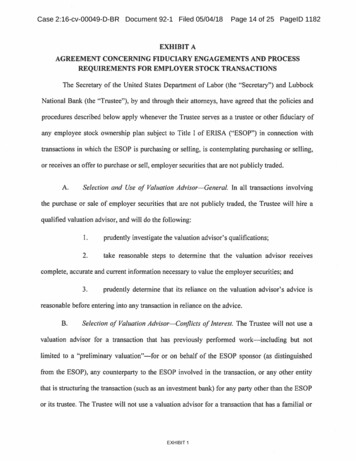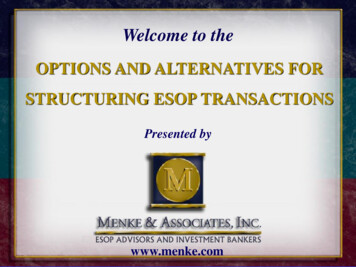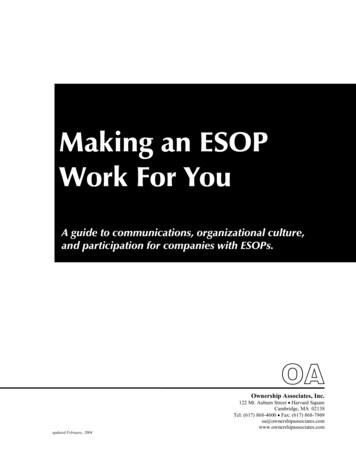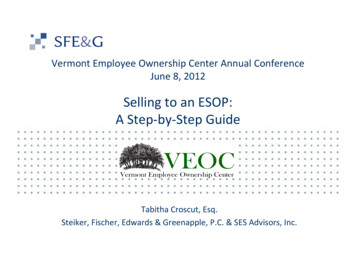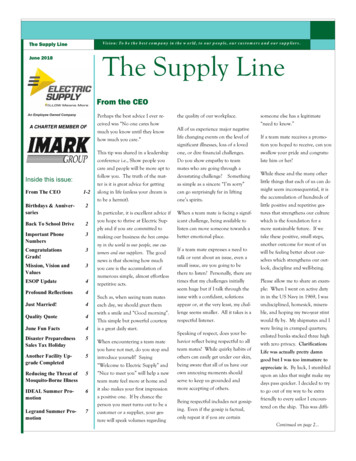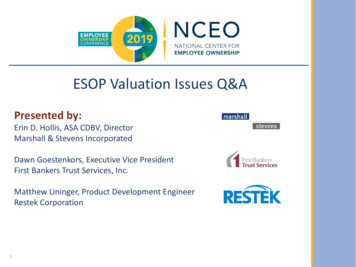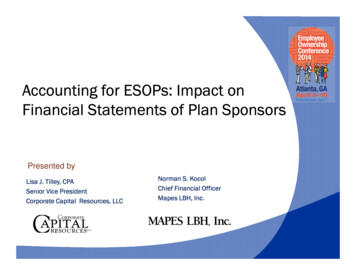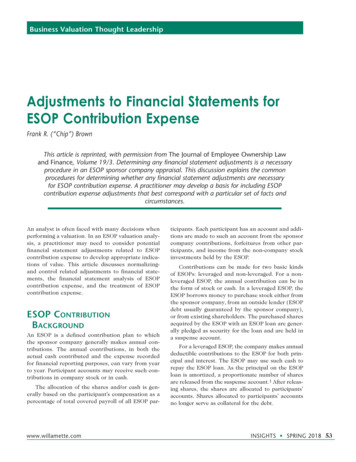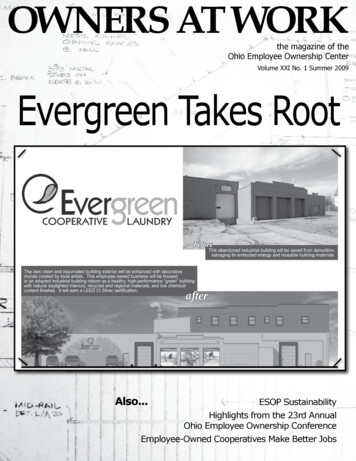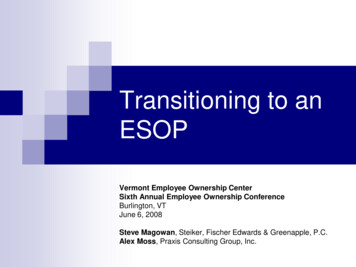
Transcription
Transitioning to anESOPVermont Employee Ownership CenterSixth Annual Employee Ownership ConferenceBurlington, VTJune 6, 2008Steve Magowan, Steiker, Fischer Edwards & Greenapple, P.C.Alex Moss, Praxis Consulting Group, Inc.
Presentation GoalsWe’re going to discuss the ten or elevenkey issues you must consider when youdesign an ESOP We’re going to offer ideas of how to createemployee involvement in the plan designprocess We will go over your questions VEOC June 6, 2008Magowan & Moss Transitioning to an ESOP1
The ESOP PerformanceAdvantage Before getting into design issues it is importantto recognize that there is a documented ESOPperformance advantageESOP companies do better than their peers - they last longer, provide better benefits, have taxadvantagesBUT . . . .VEOC June 6, 2008Magowan & Moss Transitioning to an ESOP2
The ESOP PerformanceAdvantage (2) The performance advantage only arises whenemployees are empowered and informed inconnection with the existence of the ESOP So, this leads to our discussion Canthe ESOP be designed in a way to fosteremployee involvement in order to enhance thepossibility that the adoption of the ESOP will lead tothe ESOP performance advantage? We think the answer is “Yes!” – both the substantiveESOP rules and the decision-making process itselfVEOC June 6, 2008Magowan & Moss Transitioning to an ESOP3
Building the “Perfect” ESOP Before turning to the dry requirements of ERISA and theInternal Revenue Code, let’s ask ourselves, why do wedo employee ownership?There are in fact many competing reasons - - ownersseeking diversification, managers needing a tax efficientvehicle for a buyout, owners wanting to benefitemployees, etc.But what drives the “movement?” Aside from desiring toobtain knowledge, why do people come to theseprograms and why are they so charged up after theyleave?VEOC June 6, 2008Magowan & Moss Transitioning to an ESOP4
Building the “Perfect” ESOP (2) We would say that the reason is becausethey care. Employee ownership is an ideathat captures peoples’ attention. It is in asense a form of “common capitalism,” acollective striving for commercial successthat recognizes the intrinsic value of hardwork and the external rewards that comewith hard work.VEOC June 6, 2008Magowan & Moss Transitioning to an ESOP5
Building the “Perfect” ESOP (3) To build the perfect ESOP, we need to recognize theseaspirational aspects of employee ownershipIf we do recognize these aspirational aspects in thecontext of the business studies demonstrating the ESOPPerformance Advantage, we must come to the followingconclusion: Building the perfect ESOP requires not onlya discussion of the principal legal rules, but also adescription of the optimal processes used to makechoices under these legal rulesThe process of determining the design of the ESOP thusbecomes as important as the ultimate results of thedesign discussionVEOC June 6, 2008Magowan & Moss Transitioning to an ESOP6
Building the “Perfect” ESOP (4) Outcomes, if we do it right Betterplan design decisions Better employee buy-in – understanding andacceptance – due to better engagement upfront Clarity around decision making principals: weare modeling the opportunities (and limits) ofemployee inputVEOC June 6, 2008Magowan & Moss Transitioning to an ESOP7
Building the Perfect ESOPCompany The consideration of how to build the perfect ESOP willof necessity lead to the more complex problem of how tobuild the perfect ESOP companyAs we work through the problem of the perfect ESOP,let’s also think about what the perfect ESOP companywould look like. How would it reflect our individual goalsand values? How would it run in order to be competitivein the marketplace? How would the views ofemployee/stakeholders be reflected in the day to dayoperations of the company? What are the legalconstraints in designing the perfect ESOP company?VEOC June 6, 2008Magowan & Moss Transitioning to an ESOP8
Outline of a Sample InclusivePlan Design Process Leadership identifies Overallobjectives Specific ESOP issues for consideration Constraints – what’s not on the table Decision-making parameters –recommendation vs. final authority Team member criteria Team member selectionsVEOC June 6, 2008Magowan & Moss Transitioning to an ESOP9
Outline of a Sample InclusivePlan Design Process (2) Employee Team studies alternativesof meetings – often several meetings, severalhours each Reading / research – legal issues, and benchmarking Series Employee Team presents recommendations Issues considered Alternatives Recommended plan design featuresLeadership reviews and makes final decisionsPeriodic reviewVEOC June 6, 2008Magowan & Moss Transitioning to an ESOP10
ESOP Design: Eligibility,Participation and Vesting “Eligibility” concerns who will be permitted to become a“participant” in the ESOP.“Participation” refers to which participants will receivestock and/or other benefit allocations to accountbalances under the ESOP.“Vesting” is a term that means ownership, and refers tohow much of a participant’s account (including interestand earnings) a participant is entitled to at any point intime - even though those benefits are not payable to theparticipant until he or she retires or otherwise terminatesemployment with the Company.VEOC June 6, 2008Magowan & Moss Transitioning to an ESOP11
ESOP Design: Eligibility,Participation and Vesting Eligibility, participation and vestingtogether perform a gate keeping functionfor the ESOP by setting the minimumcriteria employees must meet to obtainbenefits through the ESOP.VEOC June 6, 2008Magowan & Moss Transitioning to an ESOP12
ESOP Design: Eligibility,Participation and Vesting There are no Company dollars directly atstake initially in decisions concerningvesting, participation and eligibility.Company contributions to the ESOP willbe based upon ESOP debt service and/orCompany discretion.VEOC June 6, 2008Magowan & Moss Transitioning to an ESOP13
ESOP Design: Eligibility,Participation and Vesting Nevertheless, there are several important concerns atstake in determining eligibility, participation and vesting,including: VEOC June 6, 2008maintaining a covered base of employees with payroll highenough to avoid IRC contribution limits (i.e., contributionscannot, generally, exceed 25% of payroll);addressing personnel concerns related to using ESOPincentives to motivate management and other employees andachieve higher productivity/levels of service; andensuring that the vesting schedule does not create futureliquidity problems based upon the Company’s obligation torepurchase Company stock from departing employees withvested balances.Magowan & Moss Transitioning to an ESOP14
ESOP Design: Eligibility,Participation and Vesting The Company must determine: (i) whichemployees are permitted to participate, (ii)the period of service required beforeeligible employees can participate, (iii) theperiod of service for vesting, and (iv)whether there will be credit for vestingpurposes for years of service prior toadoption of the ESOP.VEOC June 6, 2008Magowan & Moss Transitioning to an ESOP15
Considerations How much wiggle room do you have on each issue?What are the underlying values and goals that shoulddrive these decisions? VEOC June 6, 2008Incentive theory: who can drive value in your business?Broad-based vs. narrowly held ownershipInclusion vs. centralized decision-makingPerceived fairness / sense of ownershipPerceived importance to participantsGive more, ask for more in returnCost / administrative burdenOther considerations?Magowan & Moss Transitioning to an ESOP16
ESOP Design: Eligibility,Participation and Vesting There are two primary types of minimumparticipation standards: Coverage-- an ESOP must cover a broad group ofemployees to ensure that the ESOP does notdisproportionately benefit higher paid employees. Eligibility -- an ESOP may not impose onerous age orminimum service requirements as a condition foremployees to participate in the plan.VEOC June 6, 2008Magowan & Moss Transitioning to an ESOP17
ESOP Design: Eligibility,Participation and Vesting Coverage - - An ESOP must cover either: (1) atleast 70 percent of Company non-highlycompensated employees; or (2) a percentage ofCompany non-highly compensated employeesthat is at least 70 percent of the percentage ofCompany highly compensated employees whoare covered by the plan. HCE equalsemployees making more than 105,000 (in2008; adjusted annually for inflation)VEOC June 6, 2008Magowan & Moss Transitioning to an ESOP18
ESOP Design: Eligibility,Participation and Vesting Age and Service - - An ESOP may require, as acondition of participation in the ESOP that: (1)an employee be at least 21 years old and (2) anemployee complete one year of service for theemployer. An ESOP may require two years ofservice as a condition of participation if theparticipants are thereafter immediately vested.“Year of service” is no more than 1,000 hours.Employer can lessen the amount of hoursVEOC June 6, 2008Magowan & Moss Transitioning to an ESOP19
ESOP Design: Eligibility,Participation and Vesting Coverage and Age & Service - - The Employeralso has to figure out when the employee entersthe ESOP after completing the age and servicerequirements - - Right away? On the one yearanniversary? On a set entry date?A set entry date (January 1 or two to four otherset dates) make it easier to administer the planEase of administration is an importantconsiderationVEOC June 6, 2008Magowan & Moss Transitioning to an ESOP20
ESOP Design: Eligibility,Participation and VestingCoverage and Age & Service - - Howshould you go about making thesedecisions? Considerations VEOC June 6, 2008Magowan & Moss Transitioning to an ESOP21
ESOP Design: Eligibility,Participation and Vesting Participation - - Each participant in the ESOPmust perform a certain amount of service for theCompany in order to receive an allocation of aportion of the Company’s contribution to theESOP for a given plan year. Typically, aparticipant must complete 1,000 hours of serviceduring the plan year and be employed by theCompany as of the last day of the plan year inorder to participate in the plan for that plan year.VEOC June 6, 2008Magowan & Moss Transitioning to an ESOP22
ESOP Design: Eligibility,Participation and Vesting Participation - - Last Day rule: Somecompanies with a seasonal workforceeliminate the “last day” requirement. Some companies that receive substantialreimbursement of ESOP “costs” by agovernmental agency reduce the hourrequirement and eliminate the “last day” ruleto increase participation and thereby increasethe governmental reimbursement.VEOC June 6, 2008Magowan & Moss Transitioning to an ESOP23
ESOP Design: Eligibility,Participation and VestingParticipation - - How should you go aboutmaking these decisions? Considerations VEOC June 6, 2008Magowan & Moss Transitioning to an ESOP24
ESOP Design: Eligibility,Participation and Vesting Vesting - - Vesting refers to the period of time that aparticipant must work for the Company before he or shehas a nonforfeitable right to the account balance underthe ESOP. When an individual terminates employmentwith the Company and has a sufficient “break in service,”the non-vested portion of his or her individual ESOPaccount balance is forfeited and the forfeited amountsare reallocated to the individual accounts of other planparticipants. The vested portion of a departingemployee’s individual account balance is non-forfeitableand is used to pay benefits to the departing employeeaccording to the terms of the ESOP.VEOC June 6, 2008Magowan & Moss Transitioning to an ESOP25
ESOP Design: Eligibility,Participation and Vesting Vesting - - “scaled” vesting and “cliff” vesting. A scaledvesting schedule provides that a portion of a participant’sindividual account under an ESOP becomesprogressively vested each year until the entire account isvested. The maximum permitted scaled vestingschedule is a six-year schedule by which 20 percent ofan individual’s account balance under an ESOP isvested after two years of service and increasingly vestedin twenty percent increments so that a participant’s entireaccount balance is fully vested after six years of service.Cliff vesting maximum term is three yearsVEOC June 6, 2008Magowan & Moss Transitioning to an ESOP26
ESOP Design: Eligibility,Participation and Vesting Vesting - - How should you go about makingthese decisions? A significant vestingrequirement places an obligation uponparticipants to demonstrate commitment to theCompany before becoming entitled to a benefitfrom beneficial ownership through the ESOP.The Company must balance concerns about thevesting period in a manner that is bestcalculated to motivate employees and make theCompany more productive and profitable.VEOC June 6, 2008Magowan & Moss Transitioning to an ESOP27
ESOP Design: Eligibility,Participation and Vesting Vesting - - The Company should identify the“foreseeability” of vesting to entry-level employees todetermine which vesting period will best encourageemployees to continue with the Company. If the period istoo long, vesting is not foreseeable and employeesremain unmotivated. If the vesting period is too short, theability to become vested will not by itself encourageemployees to remain with the Company.If eligibility and participation requirements are moreliberal, vesting is the key gatekeeperVEOC June 6, 2008Magowan & Moss Transitioning to an ESOP28
ESOP Design: Eligibility,Participation and Vesting Vesting - - Employees at different levels will havedifferent concerns regarding vesting. The “foreseeability”period for employees at different levels may varysignificantly. Longer term management employees, whogenerally have more years of service for the Company,will be most concerned that prior years of service becredited in determining vesting. The Company will needto balance its desire to reward its existing long-termemployees by crediting prior service with its ability to usea vesting period to motivate employees to continue towork for the Company.ConsiderationsVEOC June 6, 2008Magowan & Moss Transitioning to an ESOP29
ESOP Design: Eligibility,Participation and Vesting If prior service is totally or partially credited, along vesting period will be positive for managersas there will be more forfeitures by shorter termemployees. Lower and mid-level employees willdesire a shorter vesting period. A shortervesting period will make the benefit of the ESOPmore tangible to them.ConsiderationsVEOC June 6, 2008Magowan & Moss Transitioning to an ESOP30
ESOP Design: Contributions ESOP contributions are subject to taxdeduction limits, individual allocation limits,special allocation rules, and timing rules.The ESOP must also provide for a formulafor allocation of ESOP contributions. TheCompany must carefully consider plandesign and transaction design alternativesin light of these rules.VEOC June 6, 2008Magowan & Moss Transitioning to an ESOP31
ESOP Design: Contributions Key rules: 25%of payroll 100% of compensation or 46,000 “Considered compensation” of 230,000 in2008VEOC June 6, 2008Magowan & Moss Transitioning to an ESOP32
ESOP Design: Contributions Compensation can be defined in a way that is differentfrom all compensation. The Company could for examplenot include bonuses or the amount of compensationcould be capped in order to spread the ESOP benefitsmore broadly.Query, would an ESOP company be better served with aflat compensation definition model (say by ignoringcompensation over 100,000) and a non-qualified stockrights plan for executives?VEOC June 6, 2008Magowan & Moss Transitioning to an ESOP33
ESOP Design: Contributions Contribution formula - - The contribution formula isusually based on payroll. Most ESOPs provide forallocations of contributions (including employersecurities) in proportion to the eligible compensation ofall employees who have 1,000 hours of service duringthe plan year and who are employed as of the last day ofthe plan year.Other formula VEOC June 6, 2008Seniority / service basedHybrid: balancing compensation and service using a pointssystemMagowan & Moss Transitioning to an ESOP34
ESOP Design: ContributionsContribution formula - - How to go aboutmaking this decision? Need to bear inmind the administrative complexity. Considerations VEOC June 6, 2008Magowan & Moss Transitioning to an ESOP35
ESOP Design: Voting of StockIt is now time to go down to the Piraeus,as it were, and discuss voting of stock ERISA only requires participant voting ofstock in very limited instances, as we shalldiscuss Perhaps, though, the perfect ESOPrequires something more than theselimited rules VEOC June 6, 2008Magowan & Moss Transitioning to an ESOP36
ESOP Design: Voting of Stock ESOPs must grant participants the right to votestock allocated to their individual ESOPaccounts on certain key corporate issues suchas merger, recapitalization and dissolution. TheESOP trustee need not, however, consult planparticipants when voting company stock on othermatters (such as the election of directors),unless required by the ESOP plan document.VEOC June 6, 2008Magowan & Moss Transitioning to an ESOP37
ESOP Design: Voting of Stock Pass through voting for the Board is permittedConventional voting complexities still apply Votingfor a pre-determined slate, who nominates theslate, plurality vs. majority voting, etc. Generally state law issues, not ESOP issues butdeeply affect perceived fairness of voting process ESOPs can also permit voting on a one person –one vote basis (the “Democratic ESOP”)VEOC June 6, 2008Magowan & Moss Transitioning to an ESOP38
ESOP Design: Voting of Stock One important reason for using an ESOPis to motivate employees and to create asense of employee ownership as well asthe fact of employee ownership in acompany.VEOC June 6, 2008Magowan & Moss Transitioning to an ESOP39
ESOP Design: Voting of Stock There is ample data to suggest that ESOP companiesthat adopt participative management styles outperformboth other non-participative ESOP companies andconventional companies. ESOP participants also tend tovote their stock more conservatively than outsideowners.Participation, whether through voting or through othermeans (including greater information to, and feedbackfrom, employees) will be important for the ESOPtransaction to achieve legitimacy and appear beneficialto the average Company employee.VEOC June 6, 2008Magowan & Moss Transitioning to an ESOP40
ESOP Design: Voting of Stock Participation, whether through voting orthrough other means (including greaterinformation to, and feedback from,employees) will be important for the ESOPtransaction to achieve legitimacy andappear beneficial to the average Companyemployee.VEOC June 6, 2008Magowan & Moss Transitioning to an ESOP41
ESOP Design: Voting of StockCan there be a model of gradualbroadening of voting rights whileemployees learn how to be owners? What about using advisory votes? VEOC June 6, 2008Magowan & Moss Transitioning to an ESOP42
ESOP Design: Distributions All qualified plans, including ESOPs, mustcommence distribution of a participant’sbenefit by the beginning of the plan yearfollowing the plan year in which theparticipant retires at normal retirementage.VEOC June 6, 2008Magowan & Moss Transitioning to an ESOP43
ESOP Design: Distributions An ESOP also must commence distribution ofbenefits to a participant within one year after theplan year in which a participant terminatesemployment because of retirement at normalretirement age, disability or death, or by theclose of the fifth plan year following the plan yearin which a participant terminates employment forany other reason.VEOC June 6, 2008Magowan & Moss Transitioning to an ESOP44
ESOP Design: Distributions An ESOP is not, however, required tocommence distribution of any benefit attributableto securities acquired with a stock acquisitionloan (as long as the company was a Ccorporation at the time of the incurrence of theloan) until the loan is repaid in full, except if aparticipant dies, becomes permanently disabled,reaches normal retirement age with at least fiveyears of service under the ESOP, or reachesage 70 ½ .VEOC June 6, 2008Magowan & Moss Transitioning to an ESOP45
ESOP Design: Distributions ESOPs are also subject to a special“diversification” requirement. Participants 55years or older and with more than 10 years ofservice under the ESOP must be permitted todirect the trustee of the ESOP as to theinvestment of 25 percent of their ESOP stockaccount balance. The percentage of aparticipant’s account subject to directionincreases to 50 percent if the participant is 60years or older and has more than 15 years ofservice under the plan.VEOC June 6, 2008Magowan & Moss Transitioning to an ESOP46
ESOP Design: Distributions Form of Distribution: Participants generally maychoose to receive benefits attributable toCompany stock in stock or in cash. The ESOPmay require that participants accept their benefitin cash if the bylaws of the Company providethat employees must own substantially all of thestock in the Company or if the Company haselected Subchapter S status.VEOC June 6, 2008Magowan & Moss Transitioning to an ESOP47
ESOP Design: Distributions Form of Distribution: The Company is requiredto offer to repurchase stock distributed toemployees by the ESOP at the stock’s fairmarket value price as determined by anindependent appraiser. This “put option” may beexercised by participants either upon receipt ofthe Company stock or during a period one yearafter the receipt of the Company stock. TheCompany may choose to have the ESOPrepurchase stock rather than the Company asthe ESOP may be funded with pre-tax income.VEOC June 6, 2008Magowan & Moss Transitioning to an ESOP48
ESOP Design: Distributions Timing of Distribution: An ESOP can distribute benefitsin Company stock in a lump sum (e.g., all of the stock isdistributed to the participant at once) or in equalinstallments over five years. A Company required torepurchase stock distributed in a lump-sum distributionmay pay for the repurchased stock over five years,provided that the Company pays “reasonable” interestand provides “adequate security” for repayment.If the distribution is in stock, the repurchase obligation foreach installment distribution will be different based uponeach year’s appraisal.VEOC June 6, 2008Magowan & Moss Transitioning to an ESOP49
ESOP Design: Distributions Distribution decisions can have a big impact onthe ESOP. Do you wish to have departedemployees still partake in the value of theESOP? What can you do if you do not have achoice?Might there be good reasons to increasediversification rights?What impact does the desire to smooth outdistributions have?ConsiderationsVEOC June 6, 2008Magowan & Moss Transitioning to an ESOP50
Questions?VEOC June 6, 2008Magowan & Moss Transitioning to an ESOP51
Speaker Contact InformationAlex MossPraxis ConsultingGroup, EOC June 6, 2008Steve MagowanSteiker, Fischer,Edwards, &Greenapple, 7Magowan & Moss Transitioning to an ESOP52
addressing personnel concerns related to using ESOP incentives to motivate management and other employees and achieve higher productivity/levels of service; and ensuring that the vesting schedule does not create future liquidity problems based upon the Company's obligation to repurchase Company stock from departing employees with
